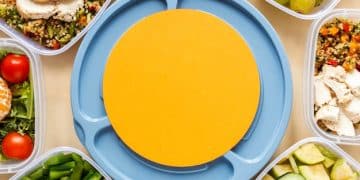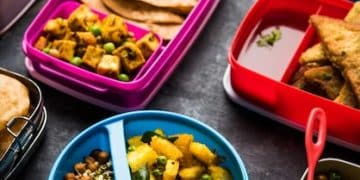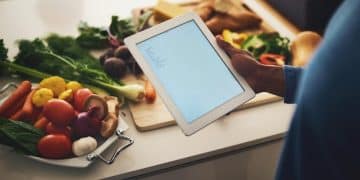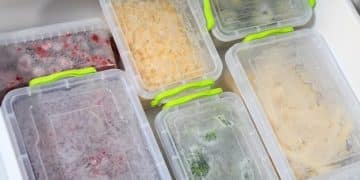Is Batch Cooking Right for You? Time & Cost Savings in 2025
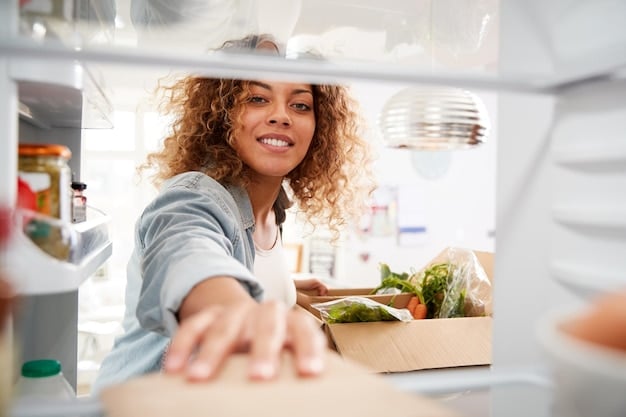
Batch cooking, the practice of preparing multiple meals in advance, can be a significant time-saver and cost-effective strategy in 2025, offering convenience and potential health benefits for busy individuals and families amid rising food prices and increasingly hectic lifestyles.
Are you constantly juggling work, family, and personal life, leaving little time for meal preparation? Could you benefit from saving money on your grocery bills? Is batch cooking right for you? A data-driven look at time savings and cost benefits in 2025 can help you determine if this strategy is the key to a healthier, more efficient lifestyle.
What is Batch Cooking? A Beginner’s Guide
Batch cooking is a method of preparing large quantities of food at one time to be eaten over several days or even weeks. It’s essentially meal prepping on a larger scale. This can involve cooking entire meals, individual components of meals, or simply prepping ingredients like chopping vegetables or cooking grains.
The core idea behind batch cooking is to streamline the cooking process and minimize the amount of time spent in the kitchen each day. By dedicating a few hours to cooking, you can free up time during the busier weekdays, making it easier to stick to healthy eating habits and avoid the temptation of takeout or processed foods.
Benefits of Batch Cooking
- Time Savings: Drastically reduce daily cooking time by preparing meals in advance.
- Cost Efficiency: Minimize food waste and restaurant spending, optimizing grocery shopping.
- Healthier Eating: Control ingredients and portion sizes for a more balanced diet.
For instance, instead of making each dinner from scratch, you might spend a Sunday afternoon cooking several different meals and portioning them into containers for the week. Alternatively, you could focus on prepping ingredients like chopping vegetables for salads, roasting a large batch of chicken, or cooking a pot of grains. These components can then be mixed and matched throughout the week to create a variety of different meals.
Batch cooking is also adaptable to various dietary needs and preferences. Whether you’re vegetarian, vegan, gluten-free, or have other dietary restrictions, you can tailor your batch cooking recipes to suit your specific needs. The key is to plan ahead, choose recipes that freeze well, and ensure proper storage to maintain freshness and quality.
In 2025, with our increasingly hectic schedules, batch cooking offers a practical solution to maintaining a healthy and balanced lifestyle without sacrificing valuable time and resources.
Assessing Your Needs: Is Batch Cooking Right for You?
Before diving into batch cooking, it’s essential to assess your individual needs and lifestyle to determine if it’s the right fit. Consider your current eating habits, time constraints, and dietary preferences. Understanding these factors will help you tailor your batch cooking approach effectively.
Take an honest look at your current weekly routine. How much time do you realistically have available for cooking? Are you constantly rushing to prepare meals after a long day at work? Do you often resort to ordering takeout due to lack of time or energy? If time management is a challenge, batch cooking can offer a valuable solution.
Consider these questions:
- How much time do you spend cooking each week?
- How often do you eat out or order takeout?
- Are you satisfied with your current eating habits?
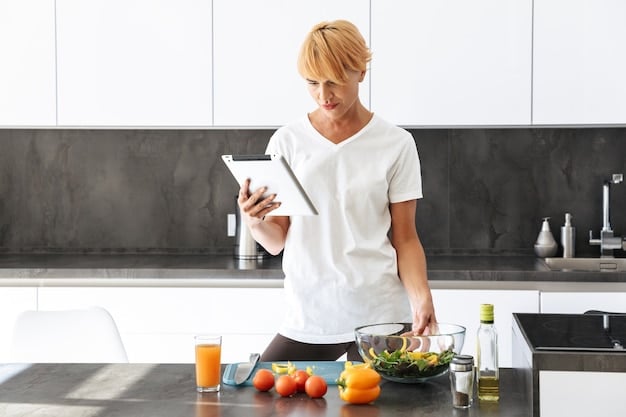
Cost Considerations
Evaluate your food expenses. Do you find yourself frequently throwing away spoiled produce or leftovers? Batch cooking can help minimize food waste by ensuring that ingredients are used efficiently. Additionally, cooking at home is often cheaper than eating out, allowing you to save money on your food budget in the long run.
Moreover, consider your dietary preferences and restrictions. Are you following a specific diet, such as vegetarianism, veganism, or gluten-free? Batch cooking allows you to have greater control over the ingredients you consume, making it easier to adhere to your dietary needs. It also ensures that you have healthy, homemade meals readily available, reducing the temptation to indulge in unhealthy processed foods.
Batch cooking isn’t a one-size-fits-all solution. It requires planning, organization, and a willingness to dedicate time to food preparation. However, for many individuals and families, the benefits of time savings, cost efficiency, and healthier eating far outweigh the effort involved. By assessing your needs upfront, you can determine whether batch cooking is the right strategy for you in 2025.
Data-Driven Benefits: Time Savings in 2025
In today’s fast-paced world, time is a valuable commodity. Batch cooking offers a data-driven approach to assessing and maximizing time savings. By understanding how much time you currently spend on meal preparation and comparing it with the time required for batch cooking, you can objectively evaluate the potential benefits.
Consider the average time it takes to prepare a meal from scratch versus heating up a pre-made batch-cooked meal. Studies have shown that individuals who batch cook can save up to several hours per week on cooking time. This time can then be reallocated to other important activities, such as spending time with family, pursuing hobbies, or simply relaxing.
Let’s look at some examples:
- Average time to cook dinner from scratch: 45-60 minutes
- Average time to heat up a batch-cooked meal: 5-10 minutes
- Potential time savings per week: Several hours
Beyond individual meals, consider the broader implications of batch cooking on your overall routine. How much time do you spend grocery shopping each week? By planning ahead and batch cooking, you can consolidate your grocery trips into a single, efficient shopping trip, further saving time.
Data from 2024 indicates that families can substantially reduce time spent cooking. A report by the Food Marketing Institute shows that families who meal plan save an average of 45 minutes per day. With the incorporation of meal planning, batch cooking builds upon this saving. In 2025, these benefits are expected to expand as technologies like smart grocery lists and recipe apps are enhanced. Furthermore, the efficiency of batch cooking can extend to cleanup. By minimizing the number of cooking sessions, you also reduce the amount of time spent washing dishes and tidying up the kitchen.
In 2025, with the adoption of smart kitchen appliances and voice-activated cooking assistants, we expect the time savings could reach a new high. These gadgets can help streamline the cooking process by automating tasks like chopping vegetables, stirring ingredients, and monitoring cooking temperatures. This will ultimately reduce the amount of time and effort required for batch cooking, making it even more appealing.
Financial Advantages: Cost Benefits in 2025
The financial advantages of batch cooking are significant and can have a lasting impact on your budget. Beyond the obvious savings from eating out less, batch cooking enables you to optimize your grocery shopping, minimize food waste, make wise use of leftovers and take control of your food-related expenses.
Take into account these factors:
- Reduced spending on takeout and restaurant meals.
- Minimised food waste through efficient meal planning.
- Bulk buying discounts for frequently used ingredients.
One of the most prominent financial benefits of batch cooking is the reduction in takeout and restaurant meals. By having pre-made, healthy meals ready to eat, you’re less likely to succumb to the temptation of ordering takeout when pressed for time.
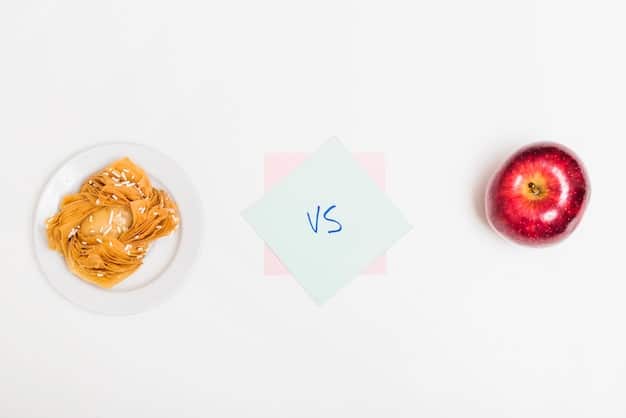
Additionally, batch cooking can help minimize food waste. Planning your meals in advance allows you to buy only the ingredients you need and use them efficiently. This reduces the likelihood of throwing away spoiled produce or leftovers, saving you money in the long run. According to Zero Waste America, approximately 40% of food in the United States is wasted. A large portion of that food is dumped from households. By incorporating batch-cooking and meal planning, food waste reduction becomes an added benefit.
Also, think about the possibilities for bulk buying. Bulk buying certain ingredients can significantly reduce your food costs when you plan meals ahead and know what you’ll use. For example, buying rice, beans, or meat in larger quantities can drive down the price per serving as long as the ingredients are shelf-stable or can be frozen.
In 2025, subscription services and online marketplaces are expected to expand. This will provide even more opportunities for discounts and bulk purchases, saving money through improved efficiency. The financial advantages of batch cooking makes it clear that this process is not only convenient, but also a smart financial choice.
Tips and Tricks for Successful Batch Cooking
To make the most of your batch-cooking efforts, consider the following tips and tricks.
Planning is the foundation of successful batch cooking. Take the time to plan your meals for the week, taking into account your dietary needs, preferences, and available ingredients. Create a detailed grocery list and stick to it to avoid impulse purchases. In 2025, advanced AI applications should facilitate sophisticated meal planning solutions by suggesting optimal meal plans based on dietary needs, local prices, and personal preferences.
Essential Tips
- Meal Planning: Plan meals in advance with dietary needs tailored to your preferences.
- Grocery Shopping: Use a detailed grocery list to avoid impulsive purchases.
- Proper Storage: Store meals correctly to maintain quality.
Choose recipes that freeze well. Soups, stews, casseroles, and chili all freeze well, making them ideal for batch cooking. Avoid recipes that contain delicate ingredients that may not hold up well to freezing, such as lettuce or fresh herbs. Remember that correct storage is key to the freshness of your batch-cooked meals. Use airtight containers, portion meals according to your needs, and label each container with the date and contents. This will help you keep track of what’s in your freezer and ensure that you consume your meals within a reasonable timeframe.
Before beginning preparing food, prioritize preparation. Clean foods, cut vegetables, and pre-portion ingredients before you start assembling all the meals. Multitasking also helps to speed things up, like roasting vegetables and cooking grains simultaneously. If you’re considering adopting batch cooking on a long-term basis, you should consider investing in some essential equipment. High-quality food storage devices will keep your meals fresh and help maximize the time in between cooking sessions. Label makers also assist to track the exact date and content of your stored meals.
Implementing successful batch cooking will require patience and learning. You will undoubtedly find what methods work for you through trial and error. Therefore, make sure you are flexible and adjust processes when a recipe isn’t working or you have unexpected schedule changes. With these tips and tricks in mind, you can get the most out of your meals.
Embracing Technology: Batch Cooking in 2025 and Beyond
Looking ahead to 2025 and beyond, technology is poised to play an increasingly important role in batch cooking. From smart kitchen appliances to AI-powered meal planning apps, technological advancements are sure to revolutionize the way we approach meal preparation and make batch cooking more efficient and accessible. We should be watching for opportunities within this niche.
Smart kitchen appliances, such as smart ovens, smart slow cookers, and smart pressure cookers, can automate many of the tasks involved in batch cooking. These appliances often come with pre-programmed settings for various recipes, making it easier to cook large quantities of food with minimal effort. In one case, these apps may even send notifications to your smartphone when your meal is ready, providing you with real-time updates on the cooking process.
Let’s consider the possibilities.
- Smart Kitchen Appliances: Automate tasks like prepping and cooking.
- AI Meal Planning Apps: Take dietary preferences and optimize shopping trips.
- Subscription Services: Tailor ingredients and offer affordable solutions.
AI meal planning apps will take dietary preferences, optimize shopping trips, and provide you with meal ideas. These apps can also track your food consumption habits, provide nutritional information, and recommend recipes based on your specific needs. Furthermore, advancements in food delivery and subscription services could offer even more convenient solutions for batch cooking.
Meal kit delivery services, which provide pre-portioned ingredients and step-by-step recipes, can be a great option for individuals who are new to batch cooking or who lack the time to plan meals and shop for ingredients. As the technology evolves, virtual reality and augmented reality applications will transform the whole cooking experience. You will be able to watch guided 3D tutorials that will walk you through the whole cooking process making a complex meal feel simpler, and easier to execute.
In 2025, the integration of technology into batch cooking will not only streamline the process but also empower individuals to make healthier and more informed food choices. From smart kitchen appliances to AI-powered meal planning apps, these technological advancements will revolutionize the way we approach meal preparation and promote a culture of convenience, efficiency, and wellness in our daily lives.
| Key Aspect | Brief Description |
|---|---|
| ⏰ Time Savings | Prepares multiple meals at once, saving hours each week. |
| 💰 Cost Efficiency | Reduces food waste and reliance on takeout, cutting expenses. |
| 🍎 Healthier Eating | Controls ingredients and helps manage portion sizes. |
| 🤖 Tech Integration | Smart appliances and apps optimize the batch cooking workflow. |
Frequently Asked Questions
▼
Meals that freeze and reheat well, like soups, stews, casseroles, and pasta dishes, are ideal for batch cooking. Consider meals with stable ingredients that maintain their texture and flavor after freezing.
▼
Properly stored batch-cooked meals can last up to 3-4 months in the freezer. Always use airtight containers, label with dates, and consume the oldest meals first for optimal freshness and taste.
▼
Essential equipment includes airtight containers, a large cooking pot or slow cooker, cutting boards, sharp knives, and a food scale. Optional items like a food processor can speed up prep work.
▼
Accurately plan your meal portions, utilize all parts of ingredients (e.g., vegetable scraps for broth), and store leftovers properly. Regularly check your fridge and freezer to use older items first.
▼
Yes, batch cooking allows for complete control over ingredients, making it excellent for managing allergies, intolerances, or dietary preferences such as vegan, gluten-free, or low-carb diets with customized meals.
Conclusion
In conclusion, is batch cooking right for you in 2025? A data-driven look at time savings and cost benefits reveals compelling advantages for those seeking to streamline their meal preparation, save money, and maintain a healthier lifestyle. By embracing technology and planning strategically, batch cooking offers a pathway to greater efficiency and wellness in the modern world.
